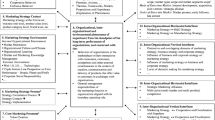Abstract
The objective of this note is to gain new theoretical insights into stockpiling phenomena. The model used to derive our results envisions consumers as responding optimally to uncertainties in the promotion environment. We show that, all else being equal, consumers will stockpile a promoted product more intensely: (i) the lower the availability of deal opportunities, (ii) the smaller the expected deal discount, and (iii) the lower the uncertainty about the deal/regular price, provided that dealing occurs with high/low frequency.
Similar content being viewed by others
References
Abraham, Magid M., and Leonard M. Lodish. (1987). “PROMOTER: An Automated Promotion Evaluation System,”Marketing Science 6 (Spring), 101–123.
Abreu, Dilip. (1988). “On the Theory of Infinitely Repeated Games with Discounting,”Econometrica 56 (March), 383–398.
Blattberg, Robert C., Garry C. Eppen, and Joshua Lieberman. (1981). “A Theoretical and Empirical Evaluation of Price Deals for Consumer Non-durables,”Journal of Marketing 45 (Winter), 116–129.
Bolton, Ruth N. (1989). “The Relationship Between Market Characteristics and Promotional Price Elasticities,”Marketing Science 8, 153–169.
Fader, Peter, and Leonard M. Lodish. (1989). “A Cross-Category Analysis of Category Structure and Promotional Activity for Grocery Products,” working paper #89-025, Marketing Department. The Wharton School, University of Pennsylvania.
Golabi, Kamal. (1985). “Optimal Inventory Policies when Ordering Prices are Random,”Operations Research 33 (3), 575–588.
Gupta, Sunil. (1988). “Impact of Sales Promotions on When, What and How Much to Buy,”Journal of Marketing Research 25 (Nov.), 342–335.
Johnson, Norman L., and Samuel Kotz. (1970).Continuous Univariate Distributions-1. New York: John Wiley and Sons.
Klein, Robert L. (1981). “Using Supermarket Scanner Panels to Measure the Effectiveness of Coupon Promotions.” In John Keon (Ed.),Proceedings: Third ORSA/TIMS Special Interest Conference on Market Measurement and Analysis. Providence, RI: The Institute of Management Sciences, 118–126.
Krishna, Arahdna. (1988). “Consumer Expectations of Deal Frequency and Sale Price and How These Affect Purchase Behavior,” Doctoral Dissertation Proposal, Graduate School of Business, New York University.
McAlister, Leigh. (1985). “The Impact of Price Promotions on a Brand's Market Share, Sales Pattern and Profitability,” Sloan School of Management, working paper #16-22-85, MIT.
Meyer, Robert M., and Joao Assuncao. (1988). “The Optimality of Consumer Stockpiling Strategies,” working paper, May, UCLA.
Narasimhan, Chakravarthi. (1988). “Competitive Promotional Strategies,”Journal of Business 61 (4), 427–449.
Neslin, Scott A., Carolin Henderson, and John Quelch. (1985). “Consumer Promotions and the Acceleration of Product Purchases,”Marketing Science 4 (Spring), 147–165.
Neslin, Scott A., and Robert W. Shoemaker. (1983). “A Model for Evaluating the Profitability of Coupon Promotions,”Marketing Science 2 (Fall), 361–388.
Nielsen Researcher (1983). November 3, The A.C. Nielsen Company.
Shoemaker, Robert W. (1979). “An Analysis of Consumer Reactions to Consumer Promotions.” InEducators' Conference Proceedings. Chicago: The American Marketing Association, 41–46.
Ward, Ronald W., and James E. Davis. (1978). “A Pooled Cross-Section Time Series Model of Coupon Promotions,”American Journal of Agricultural Economics 60 (Aug.), 33–40.
Wilson, R. Dale, Larry M. Newman, and Manaj Hastak. (1979). “On the Validity of Research Methods in Consumer Dealing Activity: An Analysis of Timing Issues.” InEducators' Conference Proceedings. Chicago: The American Marketing Association, 41–46.
Author information
Authors and Affiliations
Rights and permissions
About this article
Cite this article
Helsen, K., Schmittlein, D.C. Some characterizations of stockpiling behavior under uncertainty. Marketing Letters 3, 5–16 (1992). https://doi.org/10.1007/BF00994076
Issue Date:
DOI: https://doi.org/10.1007/BF00994076




